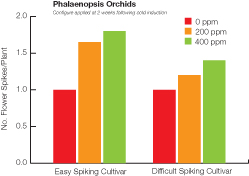10/15/2008
Boosting Orchid Profits with PGRs
Kevin Forney

Consumers and growers alike have grown quite fond of phalaenopsis. The exotic plant constitutes 75% of the more than $140 million U.S. orchid market. The widespread availability of phalaenopsis has spread orchid fever throughout the U.S., attracting experts, hobbyists and even newfound orchid lovers.
The striking plant, with its long, elegant stems and bold, moth-like blooms, can flower for months and is relatively easy to care for. And unlike many ornamentals, orchid sales have grown steadily during the past five years, bestowing their beauty on consumers and giving great value to growers.
An important factor behind the phalaenopsis buzz has been the significant strides in the commercial production of this plant. More efficient production has made the orchid easier and less expensive to grow.
The industry continues to strive to improve both the production of phalaenopsis and the plants themselves. One of these improvements is the result of the use of plant growth regulators. Certain growth regulators can increase the number of flower spikes or inflorescences, as well as branching and flower spike thickness. Growers can typically receive a 20% premium when plants have a second flower stem. For example, phalaenopsis in a 4-in. pot with one inflorescence might fetch $12 wholesale. But the same plant with two spikes might bring in $15 or even $16.
Recent trials have studied the use of benzyladenine (BA) on potted phalaenopsis. The first, a trial conducted by Matthew Blanchard and Erik Rankle from Michigan State University’s Department of Horticulture, looked at how the application of BA influenced flowering on potted phalaenopsis.
Another trial, conducted at a commercial orchid grower in the United Kingdom, studied the use of Configure, a BA product, on potted phalaenopsis. Configure, a plant growth regulator from Fine Americas, showed excellent results in boosting the number of inflorescences. Originally registered for use on Christmas cactus, hostas and purple coneflower (Echinacea spp.), Configure recently received open use approval by the EPA, making it available for use on orchids.
Recommendations
Here’s a look at some recommendations in working with Configure on phalaenopsis.
While some phalaenopsis are produced from seed, most are the product of cloning from a growing point. The cloning process reduces variability between plants and helps ensure consistent flower colors and patterns.
Orchids thrive in moist, tropical climates. Mature phalaenopsis should be grown at a constant temperature around 85F. Plants can then be transferred to a lower constant temperature of around 70F. This cold induction will induce flowering. In the U.K. trial, application of Configure was done at both 200 ppm and 400 ppm levels. Configure was applied to the point of run-off from the foliage two weeks after cold induction.
Plants should be grown under a maximum light intensity of approximately 1,500 f.c. and a 16-hour photoperiod. Phalaenopsis should also be fertilized at each watering. The use of a sticker/spreader is recommended, as it appears to hold the growth regulator at the point where it is needed.
The U.K. trial of Configure on phalaenopsis compared two clones, one known to be an easy spiking clone and one known to be more difficult. Configure increased inflorescences on both varieties.
Trial Results
The results of the Blanchard and Runkle trial at Michigan State, published in the January 2008 issue of the
Journal of Plant Growth Regulators, found that plants treated with BA at 200 or 400 mg/L had a visible inflorescence three to nine days earlier and had an average of 0.7 to 3.5 more inflorescences. Orchids receiving BA application in the study also had three to eight more flowers per plant than non-treated plants.
In the U.K. study, Configure application at 200ppm resulted in a 70% increase in spike clones in the easy-to-spike cultivar and a 20% increase in spike clones in the difficult-to-spike cultivar. Application at 400 ppm showed an 80% increase in inflorescence in the easy-to-spike cultivar and a 40% increase in spike clones in the difficult-to spike cultivar.
In addition, U.K. trial results found that the thickness of the flower spike was improved and the green color of the spike was reported to be more intense with the application of Configure. The length of the inflorescence, however, was not altered, so phalaenopsis will not suffer marketing or shipping issues due to long spikes.
Overall, Configure was found to:
• Increase the number of inflorescence
• Enhance the branching of spikes
• Increase the flower count per spike
The Future of Phalaenopsis
Orchid propagators will continue to improve upon phalaenopsis. This popular orchid, once limited in color and style, now flaunts intense yellows, desert tones, magentas and purples. Stripes, spots and bold mixes are now common themes in the new landscape of phalaenopsis. Breeders have even begun to experiment with fragrance. As this plant continues to grow in popularity and market share, and as new and even more exotic cultivars are introduced, growers can utilize growth regulators to ensure they consistently deliver only top-quality phalaenopsis.
Kevin Forney is Technical Services Manager with Fine Americas. He can be reached at kevinf@fine-americas.com, 888-474-3463.